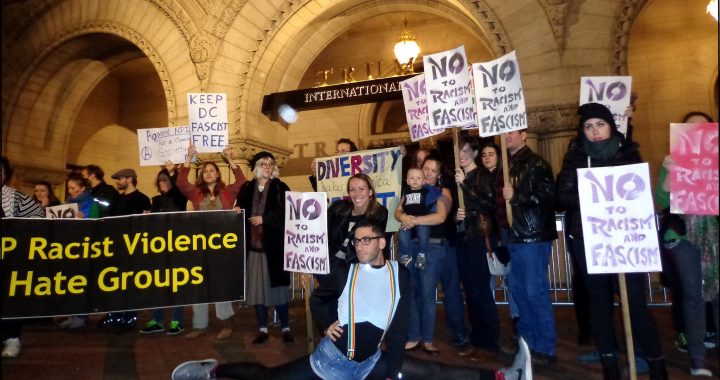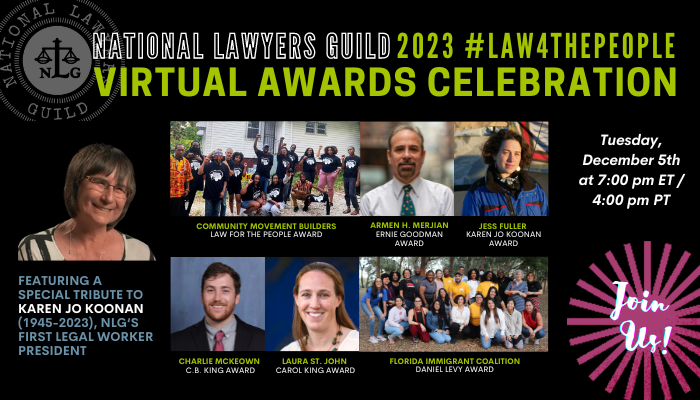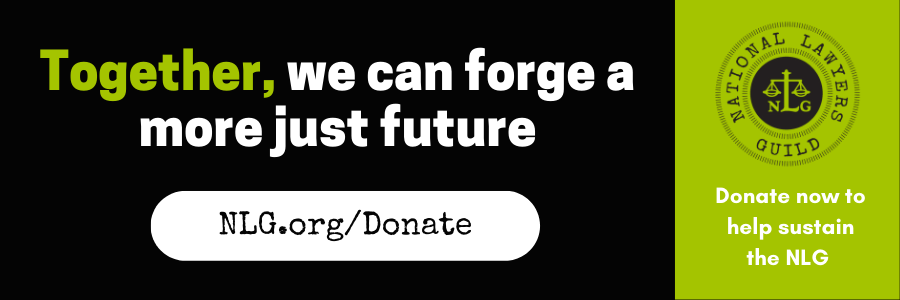By Traci Yoder, NLG Director of Research and Education
Since the election of Donald Trump in November 2016, tense standoffs between groups at different ends of the political spectrum have become increasingly common. From demonstrations at universities against hate-mongering speakers and conflicts over the removal of Confederate monuments to clashes sparked by so-called “free speech” and anti-Sharia rallies, protesters are taking to the streets in new ways on both the left and the right. These actions mark a shift in social movement tactics, which are increasingly focused on challenging the racist, homophobic, xenophobic, anti-Semitic, and misogynist agendas of far right groups emboldened by the success of Trump and his supporters. The role of law enforcement further complicates this dynamic as police are called on to mediate these disputes.
Several recent articles have provided overviews and timelines mapping the rise of fascist groups, the response of left organizers, and the questionable actions of law enforcement at the skirmishes that have followed. This account offers an analysis of the changing terrain of street protests from the perspective of social movement legal support, and considers how we might navigate the volatile conflicts now taking place between a newly mobilized far right and the anti-racist and anti-fascist forces that are prepared to fight them.
The “New” Right
Coined by white nationalist Richard Spencer in 2008, the term “alt-right” has been described by the Southern Poverty Law Center as referring to “a set of far-right ideologies, groups and individuals whose core belief is that ‘white identity’ is under attack by multicultural forces using ‘political correctness’ and ‘social justice’ to undermine white people and ‘their’ civilization.” In many ways, the alt-right is a repudiation of both the mainstream conservative establishment and multi-cultural liberalism. With its belief that it has been victimized by internal and external “enemies,” its desire to secure a “pure” national racial community through exclusion, its intense misogyny and reliance on a dictatorial male leader, and its support for draconian suppression of opposition, the alt-right is the closest the United States has come to an outright fascist movement in recent history.
Trump’s election and the media attention devoted to individuals like Spencer have facilitated a growing landscape of far-right activism. Groups that previously operated surreptitiously are now taking advantage of the reactionary political climate to openly promote their ideas and recruit members, joining newer organizations and individuals to create a confused assortment of white supremacists, white nationalists, Neo-Nazis, right-wing militias and vigilantes, online gamers, right libertarians, race realists, Christian fundamentalists, traditionalists, economic nationalists, conspiracy theorists, conservative politicians, Trump supporters, and other frustrated people looking for a fight or someone to blame. Although the majority of these organizations or perspectives are not “new,” they tended in the past to remain underground or to fester in the dark recesses of the Internet.
Despite their similarities, these various groups are rarely in full agreement about priorities, goals, or strategies. Provocative media-seeking celebrities like former Breitbart News editor Milo Yiannopoulos and Proud Boys founder Gavin McInnes have earned the nickname “alt-lite” and are considered opportunistic and untrustworthy by others identifying as alt-right. Generational differences also cause tensions as long-time white nationalist groups mingle with a younger generation politicized in online forums like 4Chan and Reddit. The relationship between Trump and the alt-right is also complicated; while many supported his campaign, others have become critical of his actions, especially his decision to bomb Syria. Finally, ideological differences and juvenile infighting are beginning to take their toll, leading to schisms and dissention. Yet despite the silly costumes and petty discord, we should underestimate neither the power of these groups nor the effects their rhetoric might produce if left unchallenged.
In recent months, the most consistent actions of these right-wing groups have included sending reactionary speakers to universities, protesting the removal of confederate monuments in the South, and organizing pro-Trump, “free speech,” and anti-Sharia rallies across the country. As I noted in a previous piece, the use of “free speech” arguments is a key tenet of this loose coalition of alt-right groups. By framing opposition to their hate speech as attacks on the First Amendment, the alt-right demonizes anti-fascists and other protesters who oppose them. In this framing of events, fascists and their sympathizers are cast as victims, while counter-protestors are accused of being authoritarians. It is hardly surprising, then, that a common refrain among alt-right forces is that antifa are the “true fascists.”
Antifa and the Left
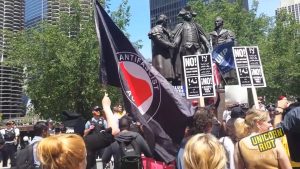
Chicago Community Members Counter-Protest anti-Sharia/anti-Islam Demonstrators (Photo by Unicorn Riot)
As the right wing presence in the media and on the streets grows, opposition responses have ranged from online condemnations and counter-protests to outright physical attacks on the alt-right’s most outspoken figures. While most are now aware of the famous punch delivered to Spencer by a masked protester during demonstrations against Trump’s inauguration, this is only the most visible example of anti-fascist efforts to ensure that the virulent white nationalism sweeping the country is met with militant resistance. Antifa commit to directly confronting fascism by shutting down far right demonstrations, depriving them of platforms to engage in hate speech, and making it difficult for alt-right forces to spread their message or recruit members.
Although the numbers of those joining anti-fascist efforts are growing, antifa itself is not new. Contemporary anti-fascist mobilization emerges from resistance to fascist regimes in Europe during the first half of the twentieth century, as well as from the more recent efforts of groups like Anti-Racist Action in the United States in the 1980s. These examples indicate that principled resistance to fascist movements has been successful in curbing their expansion; nevertheless, antifa remain controversial even on the left due to their confrontational methods. But while many abhor tactics that involve violence, historical evidence shows that direct action has contributed to shutting down fascist movements before they gain too much power or influence. When the cost of proclaiming racist, xenophobic, homophobic, and misogynist ideas becomes too great, the likelihood of people publicly supporting these positions decreases.
Antifa’s unapologetic militancy has led right-wing pundits to decry their campaign as one of “left terrorism,” a charge heard increasingly after the shooting of several members of Congress by an admitted Bernie Sanders supporter in June. Although the shooter did not identify as antifa, the incident has been conflated with the resistance to the alt-right, leading to assertions that it is anti-fascists who are inciting violence. Evidence, however, suggests that only 2% of political violence originates on the left. In contrast, 74% of violent acts are committed by individuals espousing reactionary right-wing politics. Documenting Hate shows that, since March 2017, at least 1,400 hate crimes have taken place in the United States, with at least 20% of these carried out in Donald Trump’s name. Regardless, the National Rifle Association just released an ad portraying the anti-Trump resistance as a violent threat in need of neutralization by the police and gun-toting citizens. Furthermore, antifa has recently been designated a terrorist organization by the New Jersey Office of Homeland Security.
It is a mistake to focus solely on masked anti-fascists when assessing these new conflicts. Alt-right rallies and speakers are challenged by a much broader coalition of progressive organizations and concerned individuals, including but certainly not limited to those who would identify primarily as antifa. Protests have brought together labor, immigrant, student, LGBTQ, and racial justice organizations, socialist groups, and a broad array of seasoned activists and people recently politicized by Trump’s election. Groups like Redneck Revolt work to recruit poor and working class whites away from far right reactionary politics through dialogue, community defense, and survival assistance. Finally, nonprofit organizations like the Southern Poverty Law Center, Political Research Associates, and the National Lawyers Guild have important roles to play in research, analysis, and legal support for anti-fascist movements.
Role of Law Enforcement
For decades, protesters taking to the streets to confront corporate greed, government malfeasance, imperialist wars, environmental destruction, and the oppression of marginalized groups have been met with police violence and overreaction. Crowd control techniques like kettling and the deployment of weapons such as tear gas, rubber bullets, batons, water cannons, and long range acoustic devices (LRAD) have made protesters understandably wary of police. As a result, protests often became clashes between demonstrators asserting their right to dissent, and the punitive reactions of law enforcement.
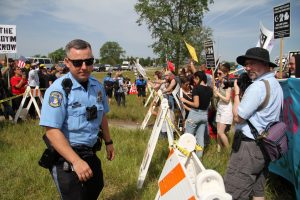
Anti-Sharia Rally and Counter-protest in Lansing, MI. (Photo by Shanna Merola)
Protest dynamics change when conflict arises between far-right groups and the counter-protesters who challenge them, leaving the police to adopt the role of ostensibly neutral mediators. However, reliance on police forces to curb the rise of fascist groups and hateful public demonstrations is not likely to be the most effective solution. Not only is there currently tacit support for these ideas at the highest levels of government, but police and far right protesters actually openly colluded in the arrest of counter-protesters at a “free speech” rally in Portland. Furthermore, police who allow neo-Nazi, fascist, and other hate groups to assemble without interference have been quick to attack, arrest, and otherwise intimidate counter-protesters.
This preferential treatment could result from criticism police have received from the left; however, it likely also arises from sympathy toward the ideas being espoused at alt-right rallies. According to an FBI report released in 2015, white supremacist groups have sought to infiltrate law enforcement communities and recruit new members from law enforcement personnel. Similarly, Department of Justice investigations of police departments in San Francisco, Ferguson, and Baltimore have all found numerous examples of racist behavior and institutionalized prejudice. There is also alarming evidence that up to 20% of the membership of Neo-Nazi and white supremacist groups have served in the United States military. Finally, armed groups like the Oath Keepers—composed of former police and military personnel—have been regularly providing “security” to alt-right demonstrations.
Implications for Movement Legal Support
The stage has been set for open and potentially violent conflicts between supporters of the far right’s creeping fascism and those who oppose their hateful agendas. But while most media coverage has painted both the alt-right and antifa as “fringe groups” comprised of political extremists looking for a fight, their differences should be given serious consideration. The alt-right advocates a white nationalist ethno-state that would violently exclude most Americans. In contrast, antifa and the broader left are fighting to defend all those who would be targeted under a fascist regime. Indeed, support for anti-fascist actions extends far beyond the masked antifa who are most visible. Many immigrants, people of color, and others in vulnerable legal positions cannot participate in these confrontations for their own safety, but benefit from the risks taken by those with more privilege.
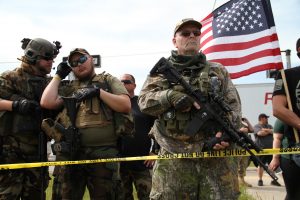
Armed alt-right demonstrators in Lansing, MI. (Photo by Shanna Merola)
The current dynamics have serious implications for movement legal supporters, who must contend with the actions of law enforcement, the provocations of right-wing protesters, and the potential collusion between the two groups. For legal observers, this requires documenting a great deal of information in an often hostile and volatile context. Right-wing protesters are also coming to demonstrations armed with deadly weapons, increasing the likelihood that someone will be critically injured or killed. This possibility became clear when two alt-right sympathizers went to a demonstration against Milo Yiannopoulos at the University of Washington in April 2017 and ended up shooting one of the protesters. This trend is likely to continue; rhetoric around these conflicts on the right is becoming so extreme that some are predicting civil war. It is naïve to rely primarily on the police, whose assigned role as neutral mediators in these conflicts is regularly compromised.
Movement legal support must also address the escalation of charges brought against protesters like those mass arrested at the inauguration protests in January. Demonstrators, journalists, and legal observers gathered on that day have been charged with felony riot and conspiracy charges, which could result in up to 75 years in prison. Across the country and in more than 20 states, we are also seeing stricter laws against protesting brought by Republican lawmakers with the aim of increasing penalties and discouraging demonstrations. Lawyers and legal workers defending those arrested at protests against the alt-right have also been targeted, and NLG members and other legal professionals representing left activists have had their personal information shared online, a practice known as doxxing.
Taking militant and confrontational direct action may not be possible for everyone; however, these tactics are a crucial part of the fight against fascism. The NLG will continue to support anti-fascists and anti-racists in the street and in the courts, and will not be swayed by the argument that hateful, dangerous speech should be tolerated at any cost. Legal professionals concerned about the rising levels of hate and prejudice in the country right now need to vigorously support all organized resistance movements. To take action, consider joining the NLG to legal observe or offer representation to those arrested while protesting. Help us continue to support the J20 arrestees and to push back against the wave of anti-protest laws currently being considered in state legislatures. Finally, show up when fascist groups organize demonstrations in your city and let them know that their hateful agendas will not go unopposed.
Main image: Anti-Trump and alt-right at Trump Hotel, Washington, DC by scottmontreal. Attribution-NonCommercial 2.0 Generic (CC BY-NC 2.0).

